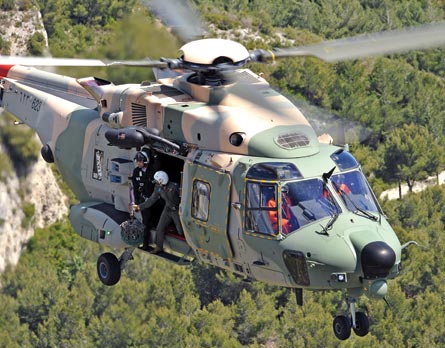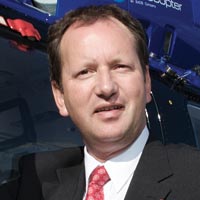Eurocopter was extant for eight years before its absorption into EADS, and the rotorcraft manufacturer has set an example not just as a pioneering exercise in European co-operation but with its tireless international expansion.
The latter has yielded major dividends in the US market. Eurocopter's Grand Prairie, Texas-based subsidiary American Eurocopter puts its share of 2009's US civil helicopter market - by units - at 53%, more than twice that of nearest rival Bell (26%), with Sikorsky and AgustaWestland taking 7% each, MD Helicopters 6% and Enstrom 1%.
|
|---|
On the global level, Eurocopter claims a 54% civil share, ahead of AgustaWestland (18%), Bell (15%), Sikorsky (7%) and smaller players.
In the military arena - where it offers the Tiger attack helicopter and, via a consortium, the NH90 - Eurocopter estimates that it took 21% of last year's global market, second to Sikorsky (30%). Its UH-72 light utility rotorcraft accounted for 13% of units ordered by the US Department of Defense in 2009, behind only Sikorsky's UH-60A/L Black Hawk transport (20%) and Boeing's AH-64D Apache Longbow attack helicopter (18%).
Overall, Eurocopter's 2009 performance indicated steady navigation of the downturn. Deliveries dropped 30 units to 558, but turnover nonetheless rose 2% to €4.6 billion ($5.8 billion). Net orders in units fell by more than 50%, but order intake by value rose 18% as demand shifted from light helicopters to heavier machines, reflecting the relative robustness of the oil and gas market.
EADS companies sometimes combine their efforts in sales campaigns: for example, security systems or military transport aircraft may be bundled with police or border-control helicopters. These opportunities are among the major benefits of group membership, says Eurocopter chief executive Lutz Bertling.
Members can also take advantage of increased bargaining power in negotiations with suppliers, with Eurocopter more formidable within a €40 billion group than as a €4.5 billion company. Additionally, the sister companies share technology via EADS's Innovation Works research unit, and have access to an expanded talent pool.
|
|---|
Eurocopter's US success in particular distinguishes it among its peers, and Bertling says innovative products have been a major factor in that success, citing the popularity of the EC135 and EC145 light twins and the single-engined AS350. He deems the local presence "decisive", commenting: "You cannot conquer the USA from Europe. You need to be seen as a US player."
Bertling detects "room for consolidation" in the rotorcraft manufacturing industry, and expects China and South Korea to become major world players in, respectively, this decade and the next. Indicative both of China's ambitions and of the importance Eurocopter attaches to the Chinese market, the two parties have joined forces to develop the EC175 medium twin.
Bertling identifies several potential areas of growth in China, including oil and gas, search and rescue and the police market. The opening of the country's lower airspace - which he expects to happen within five years - would bring an "explosion" in its VIP and corporate business, he adds.
China's military market remains off limits because of an embargo. Preference for local sourcing, meanwhile, renders some other markets inaccessible - Bertling cites Russia and Italy as examples. The UK he sees as freer and the USA as "a rather open market".
As a general rule of thumb, local final assembly lines are demanded only by contracts that cover 50 or more helicopters. Nonetheless, Eurocopter's manufacturing network is extensive. Wholly owned subsidiary Australian Aerospace not only manufactures Tiger helicopters but maintains fixed-wing military aircraft. Tending to favour majority stakes over joint ventures, Eurocopter also has operational control of Brazil's Helibras, which Bertling expects to be developing its own helicopters within a decade.
State support forthcoming to US and even some European rivals puts Eurocopter at a disadvantage, in Bertling's view. To meet the challenge, the company has pledged to invest €1.3 billion of its own money in research and development by 2014, with customer-financed development programmes contributing a similar amount. Meanwhile, its lobbying efforts continue.
"It's one of the reasons why we are international: it just allows us to speak with more governments," says Bertling. Lack of access to US military budgets may, he concedes, put Eurocopter at a disadvantage when it comes to developing unmanned helicopters, for which expects an increased role in pipeline and high-tension line surveillance.
In the shorter term Bertling does not anticipate any major recovery of the market before year end. "Since 1973 - the first oil crisis - economical crises are arriving in the helicopter industry with 24 months' delay. In other aerospace industries, it's often 18, 20 months... We are late in the cycle, and that's why we still feel it. The good side of it is, you have more time to prepare."
Eurocopter's preparations included a "transformation programme" named Shape, which targets a €200 million reduction in support function costs by 2011, plus a €500 million reduction in inventories to free up cash for research and development. Bertling is "very confident" that these targets will be achieved - perhaps bringing some ambitious plans a little closer to reality.
Discussing the X4 helicopter Eurocopter is planning as a Dauphin replacement, Bertling makes a bold promise: "Provided we get part of the risk off our shoulders, we will be extremely radical." The manufacturer has applied to participate in the €35 billion "grand emprunt" (big loan) programme initiated by the French government in 2009.
If its application is denied, it will stick to conventional, mature technologies to produce "an innovative helicopter - but just a helicopter", while if it is approved, the aim will be "something you can perhaps compare with what Airbus did when they came out with the first fly-by-wire aircraft", says Bertling. "I don't say it's fly by wire... but just in terms of the step we intend."
Plainly, innovation is still on the agenda for Eurocopter's second decade within EADS.
Source: Flight International

























